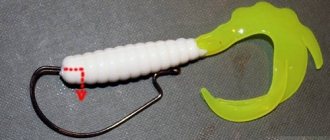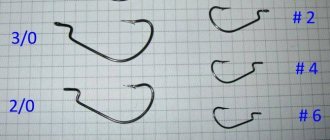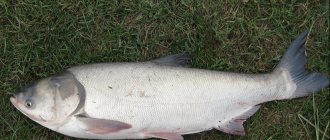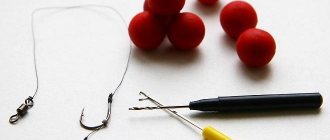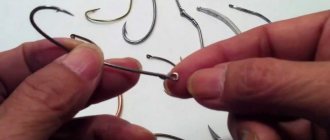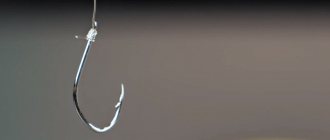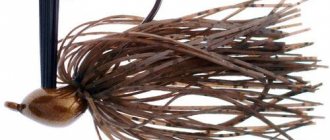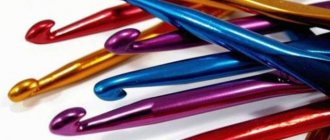BUT! We pierce perpendicular to the body of the twister (the direction of the puncture is shown in red)
Due to my line of work, I have to communicate quite often with different fishermen...
And from conversations I am surprised to understand that quite a large number of people still do not know how to properly mount bait on an offset hook.
It would seem that there is so much talk about offset hooks, so many articles... but if you think about it, I haven’t seen a simple article with photographs on how to properly put a bait on an offset hook.
Well, let's fill this gap. Below is my personal opinion regarding the offset topic. I don’t insist on 100% coverage of this topic, I’ll just share my personal experience.
Offset hooks - a brief theory on offset hooks.
“Ofsetnik” is Russian fishing slang. Derived from the English “offset hook”.
Basically, rubber (silicone baits) - twisters, vibrating tails, etc. - are mounted on offset hooks.
Here is a classic view of a mounted bait on an offset hook (don’t remember, the mounting is incorrect)
The task of the offset hook is to ensure the installation of soft bait in a non-snaking version. That is, it is “unhooked” for baits.
Offsetters have problems with fish detection.
Many people criticize offset hooks :
— Some fishermen DO NOT catch snags, but they don’t catch fish either
- and for some, on the contrary, there are solid hooks.
In fact, if you mount the offset hook correctly, you will catch the fish “as it should” - you rarely catch snags, but you accurately catch the fish.
If a rubber vibrating tail or twister is correctly installed on a hook of a suitable size, there should be a decent gap left on its hook - free space, almost the same as the height of the bait. This will allow the fish to bite the artificial bait well and hook easily.
Installation of offset hook
It’s not difficult to learn how to put on an offset hook. Any beginner, after several unsuccessful attempts, can then easily correctly attach a silicone bait, regardless of its type. You can attach a vibrotail or twister as follows:
- The bait is pierced in the head part from the end.
- The blanket is pulled completely through, and the “rubber” is fixed on the Z-shaped ledge near the eye of the hook.
- To properly attach the bait, you should attach the offset to the body and figure out where to make a puncture in order to bring the sting out in the middle.
- Now all that remains is to pierce the bait from the belly with a sting and remove it from the back.
That's it, the offset hook is installed on a vibrating tail or other type of bait. There are two options: leave the tip of the sting outside or hide it entirely in the silicone body. Both have their place and are used in different situations.
In very snaggy or overgrown places, it is advisable to hide the sting in the body of the bait. This will allow you to avoid excessively frequent snags when passing through strong locations, where even an offset hook does not always save you. When a predator bites, the “rubber” moves down the fore-end, the sting is released and eats into the fish’s mouth. The disadvantage of this installation option is the low effectiveness when grasping underwater inhabitants. Idle strikes are observed, and derailments are possible.
If fishing conditions allow, then it is better to attach a twister or other soft bait, without hiding the tip of the hook completely into the body. This increases the catchability of the equipment, it is easier to break through the predator’s mouth, there are fewer derailments and unsuccessful hooks.
Some novice spinning enthusiasts have a question about how to attach silicone baits of this type, such as worms, slugs or creatures. In fact, there is no difference with how to put on a twister. The “rubber” is first pierced from the end, then the sting is removed from the back and fixed.
Advice! For elongated, narrow-bodied rubber baits, like worms, it is advisable to use offsets with an elongated fore-end. They are labeled on the packaging as WarmHook.
How to put an offset machine on a wide-bodied vibrotail? It is advisable to use WideGap hooks. They allow you to effectively mount the “rubber” without reducing the catchability of the equipment and without changing the performance of the bait. If there are only classic offsets, then it is advisable to trim the belly of the silicone with scissors. This will slightly modify its operation, but will make it non-clinging.
We figured out how to properly put a silicone bait on an offset hook. Now it remains to consider how to tie the assembled equipment to the leash or the main fishing line.
When you want to buy such a product, you should know a few things that will help you choose a hook that won’t break as soon as you throw it.
Application area of offset hooks
The offset fishing rod was invented by American fishermen who enjoy fishing for largemouth bass. There it is mainly used in spaced rigs: Carolina, Texas, split shot, weckie, drop shot and others. It allows you to effectively fish in difficult places:
- snag;
- rocky bottom;
- thickets of aquatic vegetation.
In our realities, domestic spinning anglers use an offset hook not only in spaced rigs. With its help, classic jig rigs are mounted on an eared sinker and used in combined baits, increasing their maneuverability and the possibility of hunting in strong places.
Fishing with an offset hook allows you to minimize the number of hooks. In the current difficult economic situation, it makes it possible to reduce the cost of the fishing process while preserving the bait. Now the angler has the opportunity to fish where previously it was impossible to place a spoon or “rubber”.
The advantages of offset hook are:
- A special design that ensures that the equipment does not snag when installed correctly.
- A wide range of shapes and sizes for various baits and diverse fishing methods.
- High strength and reliability.
- With some experience, it is very easy to learn how to properly attach a silicone bait to an offset hook.
Tips for a fisherman: How to attach a silicone bait to a jig head - Let's take it step by step.
Among the disadvantages - silicone often slips, and after a bite it can tear where the sting comes out. It is necessary to constantly look at the integrity of the equipment, make sure that the bait does not fly off during a force cast or a sharp grip of a predator.
What to do in such situations? Everything is much simpler than it might seem, because it can be made from an ordinary one with a long forend. But it is also important that the steel is of high quality.
The success of the retrieve will depend on how well you make the bait from the bait. This will also affect whether the hook will cling to underwater vegetation and snags. To make a great attachment, you just need to follow the instructions.
The twister attachment is made as follows:
- The twister at the end is pierced by 5-7 mm.
- A 90 degree bend is made.
- This is done in order to repeat the Z-shaped bend.
- The hook is pulled out to the end (to the Z-shaped step).
- Next, we make a perpendicular puncture in the body.
It is necessary to make a perpendicular puncture so that the tip does not stick out, but fits neatly to the twister.
It is also important not to pierce the body after everything is done. This is a fairly common mistake.
But in this case, it is unlikely that the sting will be able to pierce both rubber and fish.
Installing a vibrating tail is very similar to installing a twister, but nevertheless is somewhat different:
- From the front (from the side of the head) we pierce the bait downwards.
- We carry the bait to the offset eye.
- We find the puncture site by trying on the hook.
- We puncture the vibrotail and bring the sting out.
When placing a silicone bait on an offset hook, you should take into account the rigidity of the material from which the bait is made; in order for the bait not to slip off the hook, it is better to pull it a little.
Criterias of choice
When you want to buy such a product, you should know a few things that will help you choose a hook that won’t break as soon as you throw it.
The choice should be approached with full responsibility. It is worth considering all factors, from size to the material from which it is made.
[THERE IS AN ANSWER] How to attach a silicone bait to a jig head?
The choice should be based on the size of the bait you are going to fish with and the size and weight of the fish you plan to catch.
Dimensions
There are 7 sizes:
- No. 1/0. Forend width - 1.25 mm. Length - 41 mm.
- No. 2/0. Forend width - 1.35 mm. Length - 44 mm.
- No. 3/0. Forend width - 1.45 mm. Length - 47 mm.
- No. 4/0. Forend width - 1.55 mm. Length - 50 mm.
- No. 5/0. The width of the forend is 1.65 mm. Length - 55 mm.
- No. 6/0. Forend width - 1.75 mm. Length - 60 mm.
- No. 7/0. Forend width - 1.85 mm. Length - 65 mm.
Materials
The materials used in the manufacture of offset presses also differ. Carbon stainless steel is mainly used, but they can also be bronzed, nickel-plated, or coated with titanium nitride. To prevent corrosion, special coatings are used.
Manufacturers
The quality of the product also depends on its manufacturer. There are many manufacturers on the market offering to buy their product. There are sellers of better quality, and there are sellers of worse quality.
Here are the manufacturers that have proven themselves best:
- Owner (Japan).
- Gamakatsu (Japan).
- Decoy (Japan).
- Mustad (Norway).
- Crazy Fish (Ukraine).
- Kosadaka (Japan).
- Maruto (Japan).
- Cannelle (France).
- Cottus (China).
- Kushiio (South Korea).
In any case, you shouldn’t save much and buy the cheapest product. It is unknown how he will behave in an extreme situation.
Perhaps because of your savings, you will not pull out the fish you have been waiting for so long. The main rule is that a stingy person pays twice.
Photo 5. How to additionally drown the offset press tip
How to attach a silicone bait to an offset hook
Using the example of the Akara Eatable Best Shad , you can demonstrate how to equip it with an offset hook. The bait has a slot at the bottom of the body so that the offset tool has free movement, and a groove on the back to recess the offset tip.
Photo 2. Groove on the back of the bait
Photo 3. Slot at the bottom of the bait
How to choose an offset hook for a silicone bait . The offset should not exceed half the body of the bait (Photo 4. 1). In this case, the bait has a length of 90 mm; an offset machine with number 2.0 is perfect for it. These are Maruto offset hooks (Maruto Spin Pro 1957 series) - quite thick wire and a sharp sting. The bait is pierced from the head (2) and placed on this step, which is located near the offset eye (2-4).
Then we try on where the offset press tip should come out (5-6), and make a puncture from below (7), bring the offset press tip out not strictly across, but slightly shift it towards the head (8) so that the offset press tip goes diagonally a little diagonally. This way the offset press will hold up much better.
Photo 4. How to put silicone on an offset hook.
Let us note once again that the bait has a groove on its back. Here the sting of the hook is hidden in it (1-2). But you can further (slightly) recess the tip of the hook and bring it out, pressing it even more towards the back (3).
Photo 5. How to additionally drown the offset press tip
Thus, we get a virtually non-interfering installation of the silicone bait with the offset tool. But when the fish bites, it’s easy to press on the silicone, and the sting immediately comes out. Accordingly, the hook follows, and the fish sits securely on the offset hook.
Photo 6. When you press on the silicone bait when biting, the sting immediately comes out.
Here you still need additional loading. Most often, this is an ordinary collapsible Cheburashka. We disassemble it, put it in the ring and put the Cheburashka back on.
Photo 7. Loading with Cheburashka.
Our installation of silicone bait with offset hook is ready.
Thus, by varying the size of the Cheburashka, its weight, we can select the bait, the same bait, for different fishing conditions, for different depths and current strengths. Just changing the Cheburashka.
So you knew that, according to statistics, the most unhooked rigs, in the course of a large number of tests, turned out to be silicone baits equipped with a permanently attached offset hook to the load (Example: Decoy VJ-36 Decido). A kind of jig head, but on an offset press. This type of equipment is best suited for fishing from a boat in snags, since casting range does not play a big role. And as you know, with a big advantage there can be no disadvantages. While this rig passes snags easily, it does not stand out for its range.
Features of the correct equipment
After purchasing a series of offset machines, it is not enough to connect them to the equipment using any existing method. It is important to clarify in advance how to attach an offset hook to a silicone bait, twister or vibrotail, otherwise the fish will often break away, turning fishing into a real test.
As mentioned above, the presence of a special design allows you to attach the silicone fish as a non-hook type. In this case, there are two modifications of non-engaging equipment:
- classic traditional,
- Texas open.
In the first option, you need to find a classic offset hook with a bend that is at a right angle. To begin with, the bait needs to be pierced in the end part and fixed on the Z-shaped step. In this case, the tip of the sting should penetrate far into the body of the bait, but not go out much. Such actions allow you to securely secure the bait on the hook, minimizing possible snags.
It is necessary to constantly monitor the sharpness of the sting so that the tip not only easily pierces the fish, but also detects the prey when hooking. Texas rig is effective for catching a variety of predatory fish, including pike perch, perch, bream, etc.
For the open method of equipping a non-hook, Wide Gap “offsetters” are used. In this case, the hook fits tightly to the surface of the silicone fish or is hidden in the corresponding groove. If the ring is pressed tightly enough, it will not catch algae and other vegetation.
When using classic jig fishing, a hook with an “eared” weight is fixed using a winding ring. But there are cases when the eye of the “offset machine” is smaller in size, which is why the ring cannot pass through. Under such conditions, you need to take pliers or side cutters and use them to bite off a third of the turn from the ring.
A number of other features
For soft jerkbaits, swimbaits and twisters, lead-loaded hooks with a weighted shank are used. Such “offsets” do not require the use of additional weights and are an effective tool for spot fishing among thickets of aquatic vegetation, grass, reeds and in other hard-to-reach areas where it is difficult to cast long distances.
As already mentioned, the tip must fit tightly to the bait, otherwise it will increase the likelihood of snags. At the same time, you should not immerse the “offset” too deeply into the body of the bait, because at the moment of a bite this can lead to the release of the fish. To put the product on correctly, just follow these instructions:
- Initially, you should pierce the head part of the silicone bait with a sting 0.5-0.8 mm deep, carefully bringing it out through the stomach so that only the tip shows from the body.
- Then the hook must be applied to the back of the vibrotail to determine the approximate location of the puncture and select the correct angle to be observed during further installation. Only after this can you insert the hook at the intended angle. If you miss the moment of selecting the correct angle of entry of the tip, this can lead to derailments.
- After piercing, make sure that the bait is securely fixed.
- To prevent the soft attachments from slipping during installation, they are slightly pulled.
- If the tip cuts into the nozzle or moves slightly to the side, it means that the insertion was done incorrectly.
Types of offset hooks:
So you knew that, according to statistics, the most unhooked rigs, in the course of a large number of tests, turned out to be silicone baits equipped with a permanently attached offset hook to the load (Example: Decoy VJ-36 Decido). A kind of jig head, but on an offset press. This type of equipment is best suited for fishing from a boat in snags, since casting range does not play a big role. And as you know, with a big advantage there can be no disadvantages. While this rig passes snags easily, it does not stand out for its range.
[THERE IS AN ANSWER] How to attach an offset hook to a silicone bait?
But, let’s say, fishing through dense aquatic vegetation is much easier with loaded offsets. In such conditions, it is not the bait or the hook that collects the grass, but often the element that touches the thickets first on the retrieve, for example, a weight and a fastener in front of the bait (Example: Decoy Worm 102 S-Switcher). Therefore, offsets with careful loading along the forearm greatly simplify life for anglers when hunting for grass pike, in river bays, at the tops of ponds and reservoirs, and in completely shallow waters.
Offset hooks vary in size by number. When choosing the size of an offset hook, you need to take into account the size of the silicone bait that will be mounted on this hook, as well as the size of the fish you intend to catch.
Basic installation methods on offset presses
The scope of offsets is impressive. They can be used to solve narrowly targeted problems in a specific situation, or they can be used to make universal equipment that can catch in various conditions in any reservoir.
As mentioned above, offset is very popular in combination with hinged mounting. But more often it is used in various versions of spaced equipment, such as
- diverter leash;
- Texas with a bullet load;
- Carolina rig;
- drop shot;
- split shot.
The invention of offset made fishing in hard-to-reach places more efficient and less expensive. You can fish with offset in places where it is impossible to do without it.
- Bait Breath SL-Remix: detailed review
- All about feedergam
- What to use to catch crucian carp?
- How to store bloodworms
Where are offset hooks used?
The main purpose of an offset hook is to fish in places that are difficult for bait to reach: snags, rocky areas of a reservoir, places with flooded dead wood, cluttered places, places heavily overgrown with underwater vegetation. These are the places that predatory fish often choose for their camps. Using an offset hook for fishing significantly increases the capabilities of the spinning rod, increases the size of the catch and reduces the loss of bait.
Among the Owner offset machines, the most interesting models are models 5137 and 5140, which differ not only in configuration, but also in size. The 5137 hook model is considered more universal, since it is designed for soft plastic baits with a fairly thick body, so its shape has a pronounced rounded configuration on the bend and shank.
I would like to share my experience regarding some of the nuances of the proportionality of soft baits and hooks for them.
In this article we will talk about offset hooks (the most popular and most often used). It seems that there shouldn’t be any problems - I bought a twister or vibrotail, tried it on the hook I liked, and that’s it. But it's not that simple. A knowledgeable spinning fisher sometimes has to spend a long time selecting the required hook size for the required rubber, because this is one of the components of success in getting a bite.
Since we are talking about offset fishing rods, it is necessary to say that they were originally invented for fishing in snags. The specific geometry allows the hook to be positioned with the tip up and in the direct direction to the ring, which ensures that it does not catch on snags (but not without exceptions). I will focus on the most popular hooks and the ones that often use rubber.
Each brand of hooks comes in a different number of sizes. Most often, the problem becomes a complete discrepancy between the size of one brand and another. For example, Owner offset printers models 5137 and 5140, where the number 1/0 of one model fundamentally does not correspond to another model with the same number. The same is true among other brands - Gamakatsu worm offset ewg No. 2 and Maruto 3314 No. 2. The list of such discrepancies can be continued for a long time. But this is one of the reasons for the problematic selection.
Among the Owner offset machines, the most interesting models are models 5137 and 5140, which differ not only in configuration, but also in size. The 5137 hook model is considered more universal, since it is designed for soft plastic baits with a fairly thick body, so its shape has a pronounced rounded configuration on the bend and shank.
Basically, my comrades and I fish with Gamakatsu hooks, which are distinguished by their versatility and the properties of high-carbon steel - the necessary rigidity, which cannot be said about others. This plus allows you to cut through the hard mouths of pike perch and eliminate gatherings of large fish.
Hook Features:
How to choose offset hooks
Tips for choosing offset hooks will greatly simplify the search for good models that will be effective under different circumstances. To choose a quality option, you need to consider its main characteristics in advance, including:
- Configuration
- Size (by the way, even if different models of hooks have the same number, their sizes may differ).
- The degree of hook point.
- Ring diameter.
- The thickness of the manufacturing material.
- Hardness of silicone bait.
It is important to note that an incorrectly selected offset size will reduce the effectiveness of hooking, since due to the lack of clearance between the nozzle and the forend, it will be problematic to hook the fish.
For example, if we are talking about installing an offset bait on a vibrating tail, then when hooking it is necessary to leave an optimal gap, which is comparable to the height of the bait. Only under such circumstances will an inhabitant of the depths easily bite through the bait and securely cling to it.
When choosing a hook, you should give preference to rigid products, since they have an increased service life and reliability. However, their sizes are quite large, which makes it necessary to string them from the side. This method ensures a more active game of the bait, creating a high-quality imitation of real wounded prey.
Key varieties by shape
If we talk about the existing options for offset printers, taking into account their shape, we can distinguish the following classifications:
- Classic models of the Texas Hook series. They have a characteristic straight bend, which provides a significant gap between the forearm and the belly of the fish used. This property is especially in demand for harder plastic, because the presence of space ensures maximum reliability of fish hooking on the nozzle.
- Offset hooks for pike and zander Wide Gap. They are an updated version of the previous variety, which is intended for Texas equipment and has two modifications: for very narrow and for high baits. Representatives of the first group have a sharp sting that points towards the fore-end. In wide versions it is directed even higher.
- “Offsetters” of the Sickle Hook class. They are considered a kind of “know-how” on the market for fishing hooks with a characteristic crescent-shaped bend. Initially they were intended for jig fishing, but today the scope of application is much wider. One of the advantages is the more reliable fixation of silicone on the bend, which is especially important for long-distance fishing or when using a weighted load. Due to its unique shape, the hook easily penetrates the side of the fish’s mouth, and also securely holds it while fishing.
- Lead loaded models. Such inventions are effective for casting spinning equipment over long distances. You can use wire or a weight as additional weight.
Dimensions and material of manufacture
To choose the right hook size, you need to take into account the type and key parameters of the bait used. It is also important to pay attention to the amount of expected production.
When choosing an offset bait, make sure that its length does not interfere with the active movements of the bait in the water column, otherwise it simply will not arouse interest in the fish. Using hooks that are too long turns a vibrating tail or other silicone product into chewing gum, reducing mobility. As for the height of the bend, it should not be less than the height of the body of the silicone fish. Otherwise, the sting will need to be threaded through the body of the bait and then brought out, which will worsen the non-hooking properties of the rig.
Carbon and stainless steel are used as manufacturing materials for offset presses. To reduce their wear due to water and corrosion, they are pre-treated with protective coatings and compounds. Currently commercially available "offsetters" can be bronzed or nickel plated. There are also models coated with titanium nitride.
Popular manufacturing companies
There is a wide variety of hooks available from different companies on the fishing gear market. But not all models exactly correspond to the price-quality parameter, so it is better to abandon budget products in favor of proven products from leading brands.
In the list of the highest quality hook manufacturers, the leading places are occupied by the following companies:
- Eagle Claw,
- Jaxon,
- joint hook,
- Owner Decoy,
- Crazy Fish,
- Mustad,
- Kosadaka.
There are other brands that sell cheap hooks, but, unfortunately, their quality is very low. With diligent use or an aggressive jerk of the fish, the forend can quickly straighten out and even fail completely, depriving you of your catch. In this case, the edge quickly becomes dull, losing its performance characteristics. As a result, the frequency of idle bites and escapes is rapidly growing.
Therefore, experienced fishermen recommend giving preference to really high-quality products from the above brands.
Improving the hook
This is not difficult to do, in 5 minutes you can make the offset machine more modern and increase its size and catch more serious fish: pike, asp, molt, pike perch:
- Unbend the tip a little.
- Using pliers, you need to bend the hook towards the ring.
At the puncture site, the silicone quickly breaks and begins to slide off during wiring. It may even fly off when casting. Many people glue it to a hook on the go. But you can go the other way: using a sliding silicone stopper (which is used to secure the sliding floats), you can support the front part of the nozzle.
